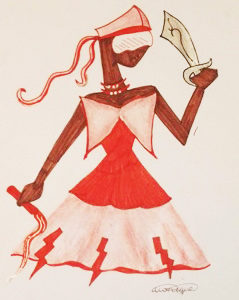Candomble is often seen as a strange and unfamiliar religion, but to those who know its cousins, one of which is the Yoruba-based Santeria—which hails from Cuba—Candomble will feel vaguely familiar.
Candomble is an African-Brazilian tradition that, over time, absorbed many Catholic tenets. The word “Candomble” means “dance of the gods” and is a religion practised by “povo do santo” or “people of the saint.” While this religion is mostly from Brazil, it has over two million followers, primarily in countries such as Uruguay, Venezuela, and Argentina.
Candomble—a History
Candomble was founded in the 19th century in Salvador, Bahia, where the first temple was raised. In all actuality, however, the religion is essentially a “creolisation” of Yoruba, Fon and Bantu beliefs from West Africa. From the mid-1500s to 1888, Candomble had been influenced by the African priests who, despite being slaves, continued to teach their mythology and culture while blending in parts of Catholicism and indigenous American traditions.
Later on, Candomble practitioners were violently persecuted for their faith by the Roman Catholic church, right up till the 1970s where the ban on Candomble was repealed and the police were allowed public ceremonies.
Faith
Candomble has its roots in Yoruba, Fon and Bantu beliefs. Followers of Candomble believe in a supreme being named Oludumare, who’s served by lesser beings called “orishas,” or “orixas” in Portuguese. Candomble is an oral tradition, so there are no scriptures to follow, and music and dance are very important to Candomble’s adherents, as music and dance allow them to be possessed by the orishas.
Another interesting aspect of the Candomble faith is that it is not a dualistic religion, meaning practitioners don’t believe in the concepts of “good” or “evil,” but rather they believe that each person has a specific destiny that they must fulfil to their greatest capacity, whatever it might be.
That said, they believe each practitioner has a tutelary, or guiding, orisha which controls the practitioner’s destiny and is that person’s protector. In Candomble rituals, orishas are presented with offerings from the vegetable, animal or mineral kingdoms.
There are other entities that belong to the Candomble religion: the voduns of the Fon and Ewe (Jeje) nations, as well as the nkisis that come from the Bantu tribe.
Because of its blend of various forms of African tradition and aspects of Catholicism, Candomble has a rich history and form of spirituality well worth exploring fully.



 One of the most important aspects of the
One of the most important aspects of the  There are many nature-and-ancestor-based religions in the world, and
There are many nature-and-ancestor-based religions in the world, and 
 Divination systems have been around since time immemorial. From the I Ching to the Tarot, everyone who has a strong connection to Spirit somehow finds their way to one divination system or another. One such divination system that’s not very well-known to the rest of the world is the art of cowrie shell reading. This divination art is often found and associated with the Afro-Caribbean and Afro-Brazilian religions, one of which is Candomble, a religion founded in Brazil around the 19th century when the first terreiro, or temple, was first built.
Divination systems have been around since time immemorial. From the I Ching to the Tarot, everyone who has a strong connection to Spirit somehow finds their way to one divination system or another. One such divination system that’s not very well-known to the rest of the world is the art of cowrie shell reading. This divination art is often found and associated with the Afro-Caribbean and Afro-Brazilian religions, one of which is Candomble, a religion founded in Brazil around the 19th century when the first terreiro, or temple, was first built. 





